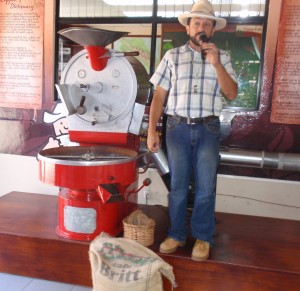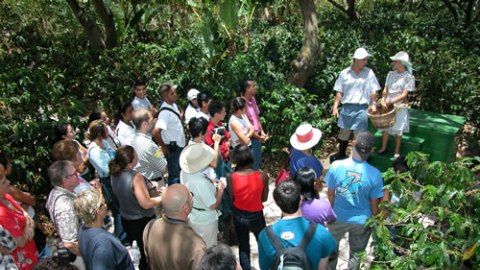No vacation to Costa Rica is complete without the very thing that put the Rica into Costa Rica- a coffee tour. When coffee first came to Costa Rica in 1750 ( via Martinique apparently whose fledgling plants were stolen from Louis XIV’s garden) little did the first growers realise that in just over a hundred years coffee would make Costa Rica a wealthy nation. The legacy of those boom days is seen in some of San José’s landmark Victorian buildings like the Teatro Nacional.
 A excellent half day trip is to take the Café Britt coffee tour, located in Barva de Heredia about twenty minutes drive from San José. Numerous agencies will book the daily 11.00am tour for you, but it’s easy to arrange it yourself and not too challenging to find with Google maps if you have your own transport.
A excellent half day trip is to take the Café Britt coffee tour, located in Barva de Heredia about twenty minutes drive from San José. Numerous agencies will book the daily 11.00am tour for you, but it’s easy to arrange it yourself and not too challenging to find with Google maps if you have your own transport.
The first thing to say about Café Britt is they don’t actually grow any coffee, which was the first of several surprises on this fun and animated entertainment. Café Britt is Costa Rica’s largest coffee roaster and producer, and their range of products now extends well beyond coffee to chocolates, cookies and candies, so the name was changed to just Britt to reflect this diversification. They pride themselves on sourcing only coffee that is grown organically.
The tour is far from a dry and dusty infomercial for Britt; it is more of a comic routine lead by two professional actors, ‘Mario’ and ‘Luis’ who take you through the history and production of coffee, through to the roasting process. A small coffee and cocoa plantation behind the roastery makes for a pleasant start to the tour as the duo’s witty banter gets the visitors smiling. The tour is bilingual and Mario and Luis make jokes both in English and Spanish, making the tour feel more like a theater production than an educational excursion.
The final part of the tour shows how coffee should be prepared, stored and tasted, which also has surprises. For instance, boiling water should never be used as it can damage the oils- the water should be just off the boil. Contrary to popular belief you should not store coffee in the refrigerator- we learned that it has an affinity for absorbing other odors and becoming tainted. As for expert tasting, the coffee is cooled down before slurping noisily to aerate the liquid and determine its character. The mark of a good coffee is that it does not change its flavour when it cools down; poor quality coffee in restaurants can be disguised by serving it very hot.
Finishing the tour we had the chance to taste various styles of Britt Coffee from the Organic Shade grown blend to the regional specialties such as the fragrant Tarrazú and milder Tres Ríos. The different climates and soils where the regional coffees are grown result in subtle differences in the ripeness and flavor of the beans. Like wine tasting, when you have all the samples together it is easier to distinguish and appreciate their different qualities. The hour and a half tour ends with an optional lunch and browse through the gift shop, where you can buy goodies to bring home to your loved ones.
If you are interested in going on this tour click on their website.
By Stewart Hird

